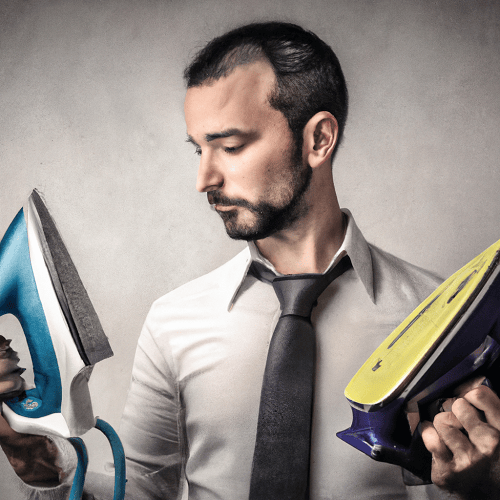Many sewers agree, if you’re not spending the same amount of time at both your sewing machine and your ironing board, then you are cheating yourself and your customers out of quality work. If you’re in the market for a new iron, how do you know what iron is right for you? We’ve compiled a list of factors that should play into your choice.

- Purpose – Most home irons are designed and marketed for general use on most fabrics. Professional sewers and tailors are a smaller portion of this market compared to users who just need to touch up the collar of their shirt. Commercial irons tend to have more advanced temperature settings, heavier soleplates, narrower tips, and a much greater steam capacity.
- Soleplate – The soleplate should also be a concern when choosing an iron. Soleplates of commercial irons are much heavier. Dry irons have smooth, holeless soles. Dry irons are ideal for delicate fabrics because they will not imprint steam holes. There are a few different theories surrounding Teflon soleplates. Some sewers say never choose a Teflon plated iron because they scratch easily. But if you are seeking a home iron with extream heat capabilities, then a Teflon soleplate might be the best option.
- Shape – The nose of an iron can be the defining feature according to some professional sewers. Take the Industrial Gravity Feed Iron for example. It has a pointed nose, perfect for doing the precise work you need.
- Weight – You can make your job much easier by choosing a heftier iron. Many professional sewers seek out the heaviest irons they can find to help them smooth out seams and folds. Irons such as the Naomoto HYS-58 Gravity Feed Iron or the Reliable Velocity 240IR 1800W Steam Iron are great choices if weight is the main concern for you.
- Steam – If you need a steam iron with an intense, long-lasting steam power, most gravity feed irons will be the best choice. If you can, take a look at the pattern of steam holes on the soleplate. Look for irons that have a nice concentration of steam holes at the tip, and evenly spread holes on the rest of the plate.
- Temperature – Most standard home irons only have 3 temperature settings – low, medium, high. Other commercial irons will have more advanced temperature settings to help if you know you will be working with a variety of fabrics and textures.
- Auto Shut-Off – We made this its own category because it can often make or break a sewer’s sanity. It can save the day in a pinch. But if the iron constantly shuts off during a longer sewing project, it can be irritating. Keep this in mind as you continue your search.